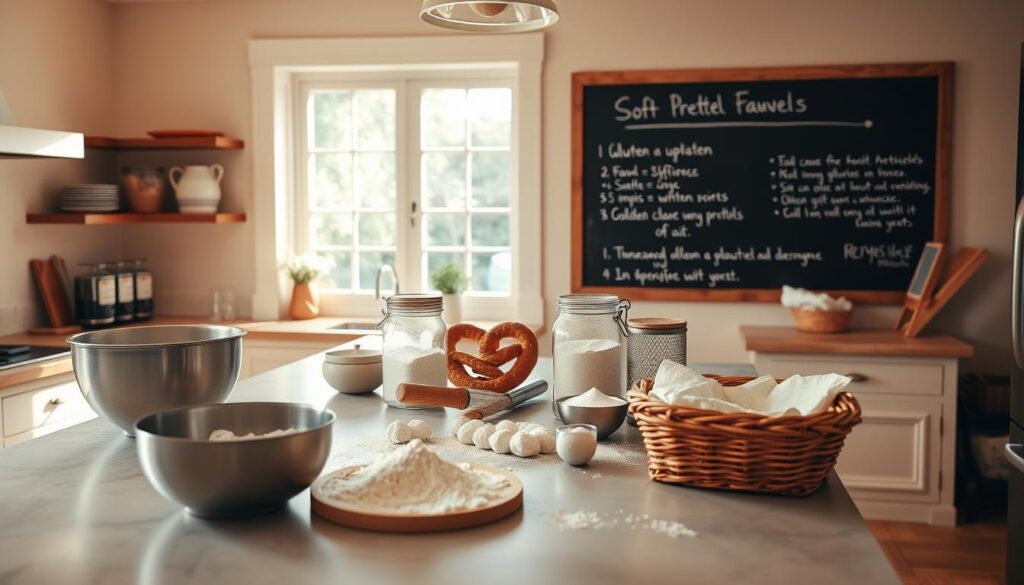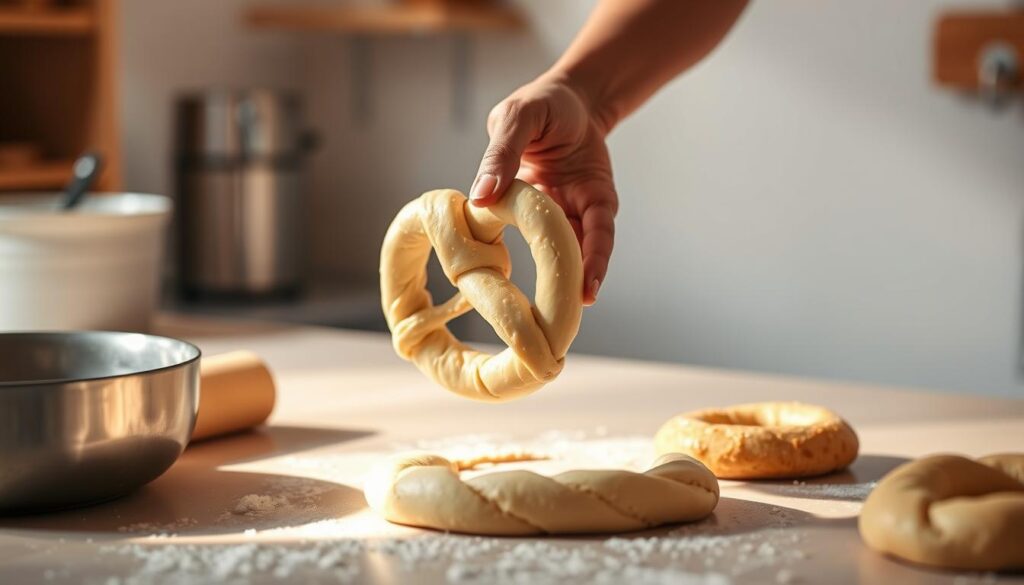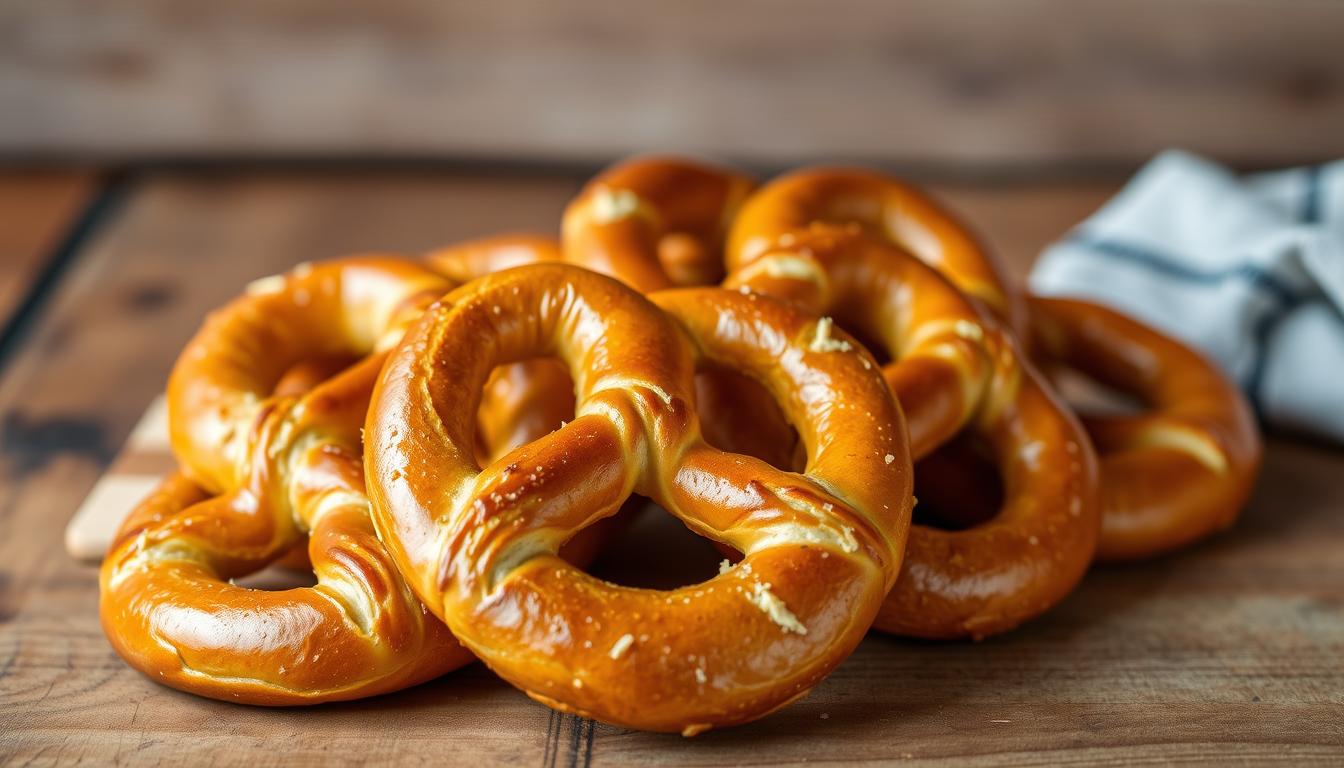Looking for a tasty snack that fits your dietary needs? Gluten free soft pretzels are here to satisfy your cravings. They offer a classic pretzel taste without the gluten. These golden treats are perfect for those who need gluten-free options.
These pretzels are inspired by Austrian Laugenbrezn. They have a chewy texture that’s just as good as regular pretzels. They’re great for anyone with gluten sensitivity or just looking for a different snack choice.
Snyder’s of Hanover has been baking for over a century. They know how to make delicious gluten-free treats. Each pretzel has just 110 calories and 2g of fat. They’re a tasty choice for those watching their diet.
Key Takeaways
- Gluten free soft pretzels provide a delicious alternative for those with dietary restrictions
- Low-calorie snack option with only 110 calories per serving
- Maintains authentic pretzel texture and flavor
- Suitable for individuals with gluten sensitivities
- Inspired by traditional Austrian pretzel-making techniques
Understanding Gluten Free Soft Pretzels
Soft pretzels have a long history, but they’re hard for those with gluten intolerance. Luckily, tasty alternatives have been made. These snacks keep the pretzel taste without wheat.
Allergen-friendly baked goods have changed for people with dietary needs. Gluten-free soft pretzels show how food can be both tasty and safe. They use special flours to make a classic snack again.
Traditional vs Gluten-Free Variations
Traditional soft pretzels use wheat flour, which has gluten. Gluten-free ones use special flour mixes:
- Brown rice flour
- Sorghum flour
- Tapioca starch
- Corn starch
Benefits of Homemade Pretzels
Making gluten intolerance snacks at home has many perks:
- You control the ingredients
- They taste fresher
- You can pick the flavors
- It’s cheaper than store-bought
History of Soft Pretzels
Soft pretzels started in European monasteries in the Middle Ages. Monks made these treats for kids who learned prayers. Now, gluten-free versions let everyone enjoy this tasty history.
The art of pretzel making continues to evolve, celebrating inclusivity and culinary creativity.
Essential Ingredients for Perfect Texture
Making tasty whole food pretzels needs the right mix of ingredients. These ingredients add flavor and texture to your snacks. Knowing how each part helps make the pretzels is key.
Start your gluten-free pretzel adventure by picking the right flour mix. Here’s what you’ll need:
- Super-fine brown rice flour
- Sorghum flour
- Tapioca starch
- Corn starch
- Whole psyllium husks
- Xanthan gum
Each ingredient is vital for a pretzel-like texture. Xanthan gum, for example, helps hold the dough together. It gives the dough the stretchiness found in wheat doughs.
| Ingredient | Quantity | Purpose |
|---|---|---|
| Brown Rice Flour | 3 ¾ cups | Base flour for structure |
| Xanthan Gum | ½ teaspoon | Binding agent |
| Salt | 1 ¼ teaspoons | Flavor enhancement |
| Instant Yeast | 1 packet | Leavening |
If you want dairy-free options, use almond or oat milk instead of regular milk. This makes a pretzel that’s good for you and tastes great.
Pro tip: Always measure ingredients precisely to ensure the perfect pretzel texture!
The Role of Specialty Flours
Making the perfect vegan pretzels needs a good understanding of specialty flours. Choosing the right flour blend is key for the texture and taste you want in gluten-free baked goods.
About 1% of the world’s population needs gluten-free options. Knowing about different gluten-free flours is important for both home bakers and chefs. Let’s look at the special qualities of gluten-free flours that can make your pretzel-making better.
Brown Rice Flour Benefits
Brown rice flour is a great base for gluten-free baking. It’s full of nutrients and has a mild taste. It’s also good for making vegan pretzels because of its benefits.
- High in fiber and protein
- Provides excellent structural support
- Offers a light, crisp texture
- Easily digestible alternative to wheat flour
Sorghum and Tapioca Starch Usage
Sorghum flour adds depth to your gluten-free bakery recipes. Mixing it with tapioca starch gives your pretzels a texture like traditional wheat ones.
Importance of Psyllium Husk
Psyllium husk is a binding agent in gluten-free baking. It helps prevent a crumbly texture and makes the dough cohesive. This is important for getting that chewy pretzel feel.
Pro tip: Always blend multiple gluten-free flours to achieve the most balanced texture in your vegan pretzels.
Preparing Your Kitchen for Pretzel Making

To make the perfect homemade soft pretzel, you need more than just ingredients. Your kitchen setup is key to making delicious gluten-free pretzels. Getting your kitchen ready can make baking a joy instead of a hassle.
Before starting your homemade soft pretzel recipe, make sure you have these tools:
- Digital kitchen scale for precise measurements
- Stand mixer or hand mixer with dough hook
- Large baking sheets
- Parchment paper
- Large pot for baking soda bath
- Silicone spatula
- Measuring cups and spoons
Pro tip: Having all equipment ready before starting ensures a smooth pretzel-making process.
Your workspace is as important as your tools. Clear a big, clean area for kneading and shaping your gluten-free pretzels. Make sure you have enough space to work comfortably and keep ingredients close.
“Preparation is the secret ingredient to successful baking” – Professional Pastry Chef
Temperature control is crucial for your homemade soft pretzel recipe. Keep your kitchen at 70-75°F to help the dough rise well. A warm, draft-free spot is best for proofing your gluten-free pretzel dough.
The Secret to Authentic Pretzel Texture
Creating the perfect homemade soft pretzel recipe is more than just mixing ingredients. It’s about two key techniques: the baking soda bath and precise temperature control.
To make an authentic soft pretzel, you need to know the special preparation methods. Your homemade soft pretzel recipe will turn into restaurant-quality pretzels with these techniques.
The Baking Soda Bath Technique
The baking soda bath is a game-changer in your homemade soft pretzel recipe. Here’s why it’s important:
- Creates the signature golden-brown exterior
- Develops the classic pretzel flavor
- Enhances the chewy texture
To get the perfect baking soda bath, mix 1/2 cup (120g) of baking soda with 9 cups (2.13L) of water. Dip each pretzel in for 20-30 seconds before baking.
Temperature Control Mastery
Getting the oven temperature right is key for the perfect soft pretzel texture. Follow these temperature guidelines:
- Preheat the oven to 400°F (204°C)
- Bake pretzels for 12-15 minutes
- Look for a golden-brown color as your doneness indicator
Professional bakers know that temperature control is crucial. With these techniques, you’ll make pretzels that are as good as any bakery’s.
Mastering the Art of Pretzel Shaping

Making the perfect gluten-free soft pretzel is more than just using great ingredients. It’s about mastering the art of shaping. Your journey in an artisanal gluten-free bakery begins with learning the delicate techniques that turn simple dough into beautiful pretzels.
Start by setting up your workspace with gluten-free flour and a clean surface. The secret to making pretzels look professional is in how you handle the dough. Gluten-free dough is fragile, so you need to be gentle.
- Divide your dough into equal portions
- Roll each piece into a smooth rope about 18 inches long
- Create a U-shape with the dough rope
- Cross the ends over each other
- Press the ends gently into the bottom of the U to create the classic pretzel twist
Professional bakers in an artisanal gluten-free bakery know that consistent shaping is key to even baking. Don’t worry if your first pretzels don’t turn out right. With practice, you’ll get better and make pretzels that look like they’re from a restaurant.
Pro tip: Lightly dust your hands with gluten-free flour to prevent sticking and make shaping easier.
Temperature and humidity can change how your dough feels. If it’s too sticky, chill it in the fridge for 15-20 minutes. Remember, each pretzel is a story of patience and skill.
Creative Topping Combinations
Take your celiac-friendly treats to the next level. Vegan pretzels can become amazing with the right toppings. Your homemade gluten-free soft pretzels need spectacular flavors to excite your taste buds.
Sweet Options
Try these sweet pretzel topping ideas:
- Cinnamon sugar blend
- Maple glaze with chopped nuts
- Chocolate drizzle
- Powdered sugar dusting
- Caramel sauce with sea salt
“The magic of pretzels is their versatility – they’re a canvas for culinary creativity!” – Gluten-Free Baking Expert
Savory Variations
For savory lovers, these toppings will make your vegan pretzels:
- Everything bagel seasoning
- Nutritional yeast sprinkle
- Coarse sea salt
- Dried herb blend
- Crushed garlic chips
Before adding toppings, brush your pretzels with egg wash or plant-based milk. This helps the seasonings stick well. Try different mixes to find your favorite gluten-free pretzel!
Storage and Freezing Methods
When making gluten intolerance snacks like homemade soft pretzels, keeping them fresh is important. Store your pretzels in an airtight container in the fridge for up to 2 weeks. This way, they stay safe and tasty for later.
Freezing is great for keeping your snacks for longer. Put the pretzels in a ziplock bag and freeze for up to 6 months. To warm up a pretzel, microwave it for 30 seconds or bake in a toaster oven for 5-6 minutes.
Wrap each pretzel separately before freezing for the best results. This stops them from sticking together and makes thawing easier. Plus, if you’ve added sweetener, the pretzels will still taste great even after freezing.
Homemade gluten-free pretzels are best eaten fresh. But these storage tips let you enjoy them whenever you want. With only 3 grams of net carbs per serving, they’re a guilt-free snack.
FAQ
Are gluten-free soft pretzels as tasty as traditional pretzels?
Yes, they are! Gluten-free soft pretzels can be just as tasty as the traditional kind. Using brown rice flour, psyllium husk, and a baking soda bath can help achieve a similar texture and flavor.
What flours work best for gluten-free soft pretzels?
The best flours for gluten-free pretzels are brown rice, sorghum, and tapioca starch. Psyllium husk is key for binding and texture. Together, they mimic the gluten found in wheat.
How can I make my gluten-free pretzels vegan?
To make vegan gluten-free pretzels, swap dairy for plant-based options. Use almond milk and flax eggs or aquafaba instead of cow’s milk and eggs. This way, you can enjoy tasty, allergen-friendly pretzels.
Can I freeze gluten-free soft pretzels?
Yes, you can freeze them for up to 3 months. Wrap each pretzel in plastic wrap and then in a freezer bag. To reheat, thaw at room temperature and warm in the oven for a few minutes.
How do I prevent my gluten-free pretzels from becoming too dry?
To keep pretzels moist, use the right flours and add moisture-rich ingredients. Psyllium husk helps, and olive oil or xanthan gum can improve texture and prevent dryness.
Are these pretzels safe for people with celiac disease?
Yes, they are safe if made with certified gluten-free ingredients in a gluten-free kitchen. Always check labels and use separate utensils to avoid cross-contamination.
What toppings work well with gluten-free soft pretzels?
You can choose from many toppings! For savory, try sea salt, everything bagel seasoning, or Parmesan (use dairy-free alternatives). For sweet, go for cinnamon sugar, chocolate drizzle, or almond glaze. Pick toppings that match the pretzel’s texture.
How long do homemade gluten-free soft pretzels stay fresh?
They’re best eaten within 1-2 days at room temperature in an airtight container. For longer storage, refrigerate for up to 4 days or freeze.

